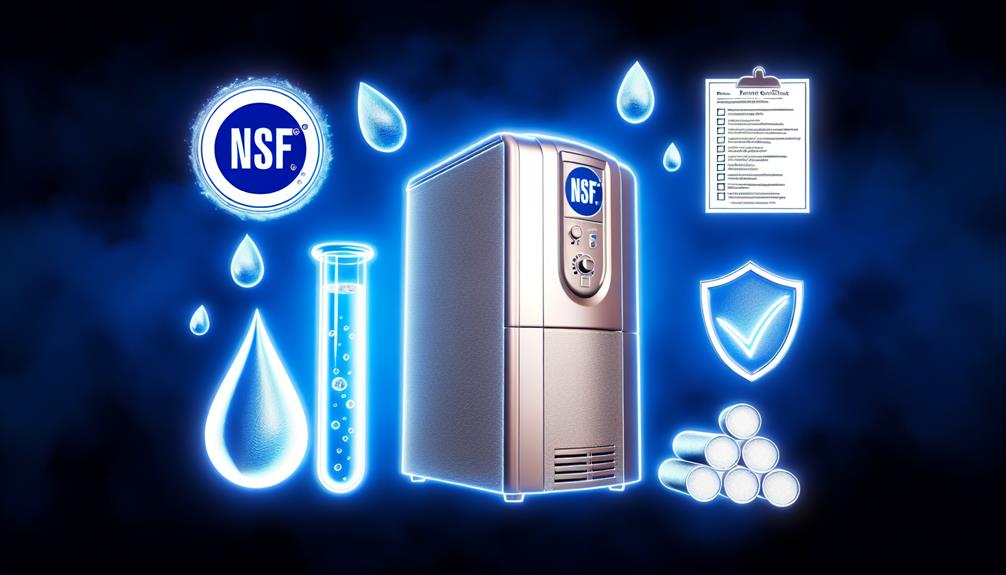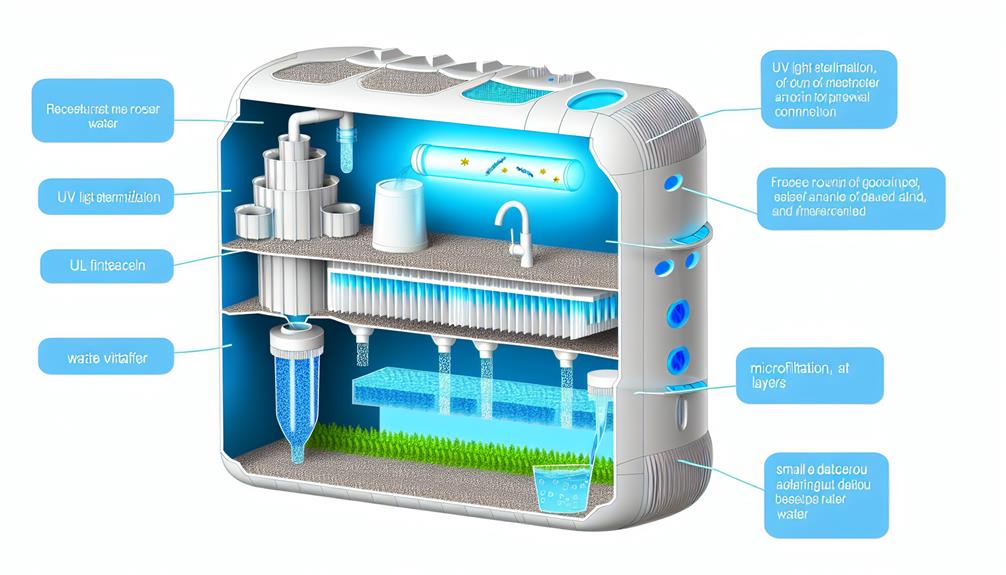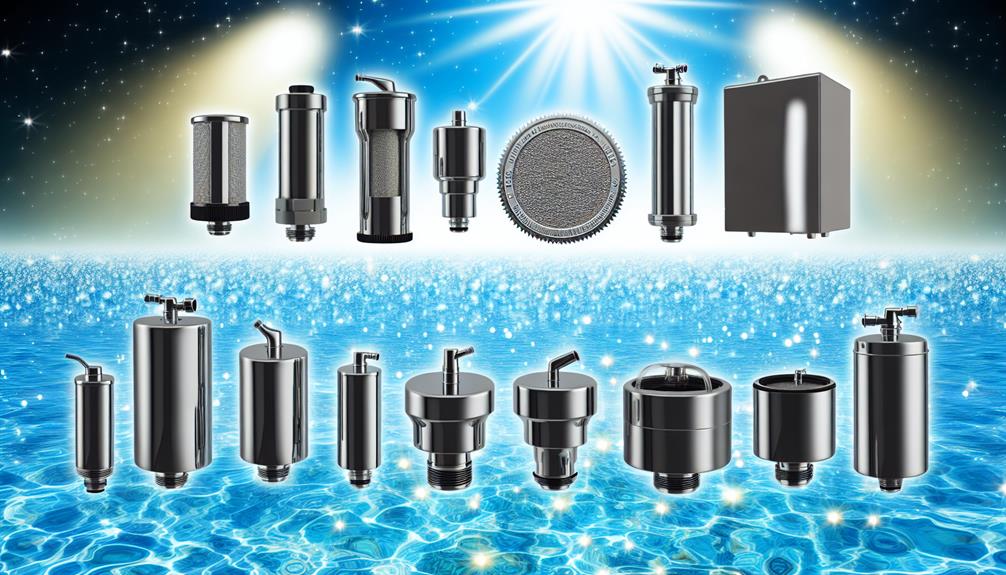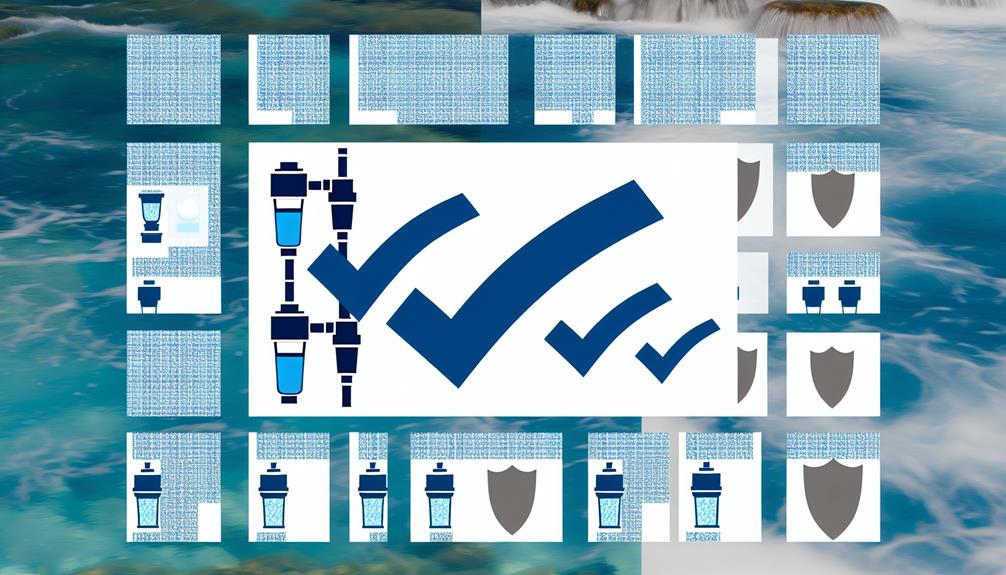As you trustingly sip water from your home purifier, you might be lulled into the comforting but perilous belief that all harmful contaminants magically shy away from your enlightened glass.
However, the vigilance required in ensuring your water purifier meets essential safety standards is far from a matter of mere sorcery. You need to familiarize yourself with the NSF certification requirements that validate the removal of specific health-related contaminants.
It's also crucial to understand how effective your system is in reducing lead—a heavy metal that has no business tap dancing through your plumbing. Furthermore, the prowess of your purifier to banish microbes and filter out toxic chemicals must adhere to stringent regulatory benchmarks.
Let's explore these critical safety standards so you can grasp what it takes to transform your trust in water purity from an act of faith to one of informed certainty.
NSF Certification Requirements

Understanding NSF certification requirements is crucial when you're evaluating the safety and performance of home water purifiers. The NSF certification process begins with a comprehensive evaluation of the water purifier to ensure it meets specific public health and safety standards. This evaluation includes rigorous testing and material analysis to confirm that the system effectively reduces contaminants as claimed by the manufacturer.
Manufacturers must also maintain consistent quality and performance in subsequent production units. To verify this, the NSF conducts unannounced plant inspections and product retesting. For you, as a consumer, the presence of an NSF certification mark on a water purifier signifies that the product has been independently tested and certified to meet strict standards for health and safety.
Consumer awareness is paramount in understanding the implications of NSF certification. You should recognize that NSF/ANSI standards cover various aspects from aesthetic effects, such as chlorine reduction, to health-related concerns including the removal of specific pathogens and chemicals. Each certified product carries a specific standard number indicating the type of treatment for which it's certified, ensuring you can precisely match product capabilities with your water purification needs.
Lead Reduction Compliance
While NSF certification assures overall safety, it's essential to specifically assess how a home water purifier complies with standards for lead reduction. You should verify that the unit meets the NSF/ANSI 53 or NSF/ANSI 58 standards, which pertain to the reduction of lead content in water. These standards are rigorous, requiring a system to effectively reduce lead levels to below the action level of 15 parts per billion (ppb) as specified by the Environmental Protection Agency (EPA).
Your analysis must consider the purifier's mechanism for mitigating pipe corrosion and material leaching, as these are primary sources of lead contamination in drinking water. It's not just about the immediate reduction of lead; long-term consistency is crucial. Look for data indicating that the system prevents leaching over its operational lifespan, maintaining compliance even as components wear.
Furthermore, ensure the water purifier's materials don't contribute to contamination. Lead-free compliance, as stipulated in NSF/ANSI 372, indicates that the wetted surfaces of a purifier contain less than 0.25% lead. This standard minimizes the potential for material leaching, safeguarding against lead entering the water post-treatment.
Microbial Purification Efficacy

To ensure your water remains free from harmful microorganisms, verify that your home water purifier meets the NSF/ANSI 55 or NSF/ANSI P231 standards for microbial purification efficacy. These standards are rigorous benchmarks designed to evaluate the elimination of bacteria, viruses, and cysts.
The NSF/ANSI 55 standard specifically addresses UV sterilization performance, ensuring that your system can effectively inactivate pathogens by disrupting their DNA.
When assessing purifiers, you should examine the system's ability to prevent biofilm formation. Biofilms are colonies of microorganisms that adhere to surfaces, including the internal components of water purifiers, potentially reducing the effectiveness of UV sterilization. A system that meets NSF/ANSI standards typically incorporates mechanisms to hinder biofilm development, maintaining optimal microbial purification efficacy over time.
Scrutinize the technical specifications of your purifier, focusing on the UV intensity and exposure time, which are critical factors in achieving thorough microbial deactivation. The flow rate mustn't exceed the design specifications, as this could compromise the UV exposure necessary to neutralize microorganisms.
Adherence to these standards is crucial for ensuring that your water purifier provides a consistent and reliable barrier against microbial contaminants.
Toxic Chemicals Filtration Regulations
Ensure your home water purifier adheres to NSF/ANSI 53 or NSF/ANSI 58 standards, which are pivotal for the reduction of toxic chemicals such as lead, mercury, and asbestos. The presence of these contaminants can have severe health implications, thus necessitating rigorous filtration processes.
When scrutinizing water purifier specifications, consider the following:
- Certification: Verify the unit possesses certification for NSF/ANSI 53 or 58, assuring it meets established requirements for toxic chemical reduction.
- Filter Lifespan: Assess the filter's operational duration; a longer filter lifespan can indicate superior quality materials and efficiency in contaminant absorption.
- Chlorine Taste Removal: Ensure the filter effectively eliminates chlorine taste, a common issue in treated water supplies, as this not only improves water palatability but also indicates a reduction in chlorine-related compounds.
A technical understanding of your water purifier's capabilities in relation to toxic chemicals is crucial. Examine the detailed performance data sheets provided by manufacturers to determine the specific percentages of chemical reduction. This analytical approach ensures you're equipped with a system that delivers not only clean but also safe drinking water.
Conclusion
You must ensure your home water purifier meets critical safety standards. Look for NSF certifications to guarantee quality and compliance.
Your system should effectively reduce lead content, adhering to stringent regulations. Verify microbial purification efficacy; it's essential for health protection.
Also, confirm the unit filters out toxic chemicals within regulated limits. These steps are non-negotiable for securing potable water and safeguarding your family's wellbeing.
Choose wisely; your purifier's performance hinges on these key safety benchmarks.

